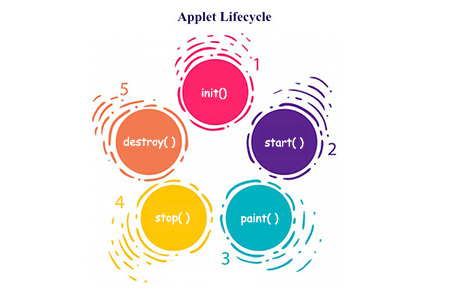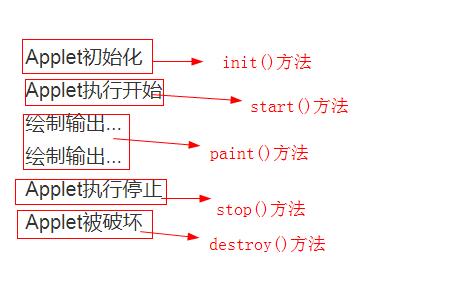What is the life cycle of Java Applet? Introduction to life cycle methods
What is the life cycle of Java Applet? This article will introduce you to the Applet life cycle and let you know what the five states and their corresponding methods are in the Applet life cycle. I hope it will be helpful to you.

What is the life cycle of a Java Applet?
The applet will go through various states between its object creation and object deletion (when execution ends). This process is called the Applet life cycle. There are 5 states in the applet, and each state is represented by a method. Therefore, there are a total of 5 methods to represent these 5 states respectively (as shown in the figure above). [Video tutorial recommendation: Java Tutorial]
These methods are called "callback methods" because the browser will automatically call them as long as the applet program needs to be executed smoothly; and the programmer just uses Some code writes methods but never calls them.
Applet’s life cycle method

##When executing the applet The method execution sequence
When the applet starts executing, the following methods will be called in the following order:1, init()2, start()3. paint( )When the applet terminates, the following method calls will occur: 1. stop( )2. destroy( )Note: The life cycle of the applet starts with the init() method and ends with the destroy() method; and these two methods will only be executed once, but other methods: start(), paint() and stop() Will be executed multiple times.Let’s take a closer look at these methods:
init() method: It is the first method called and performs variable declaration and initialization operations. The place. start() method: It is used to start the Applet, which contains the actual code of the applet that should be run. It is executed immediately after the init() method; it can also be called when the browser is maximized, restored, or moved from one window to another. paint() method: It is used to redraw the output of the applet display area. It will be executed after executing the start() method and whenever the applet or browser resizes the window. stop() method: used to stop the execution of the applet. It will be executed when the applet stops or the browser is minimized. destroy() method: used to destroy the Applet, it will delete the applet object from the memory. The destroy() method is called after the stop() method.A simple example of the applet life cycle:
The program is as follows:import java.awt.*;
import java.applet.*;
public class MyApplet extends Applet
{
public void init()
{
System.out.println("Applet初始化");
}
public void start()
{
System.out.println("Applet执行开始");
}
public void stop()
{
System.out.println("Applet执行停止");
}
public void paint(Graphics g)
{
System.out.println("绘制输出...");
}
public void destroy()
{
System.out.println("Applet被破坏");
}
}
The above is the detailed content of What is the life cycle of Java Applet? Introduction to life cycle methods. For more information, please follow other related articles on the PHP Chinese website!

Hot AI Tools

Undresser.AI Undress
AI-powered app for creating realistic nude photos

AI Clothes Remover
Online AI tool for removing clothes from photos.

Undress AI Tool
Undress images for free

Clothoff.io
AI clothes remover

Video Face Swap
Swap faces in any video effortlessly with our completely free AI face swap tool!

Hot Article

Hot Tools

Notepad++7.3.1
Easy-to-use and free code editor

SublimeText3 Chinese version
Chinese version, very easy to use

Zend Studio 13.0.1
Powerful PHP integrated development environment

Dreamweaver CS6
Visual web development tools

SublimeText3 Mac version
God-level code editing software (SublimeText3)

Hot Topics
 1667
1667
 14
14
 1426
1426
 52
52
 1328
1328
 25
25
 1273
1273
 29
29
 1255
1255
 24
24
 PHP: A Key Language for Web Development
Apr 13, 2025 am 12:08 AM
PHP: A Key Language for Web Development
Apr 13, 2025 am 12:08 AM
PHP is a scripting language widely used on the server side, especially suitable for web development. 1.PHP can embed HTML, process HTTP requests and responses, and supports a variety of databases. 2.PHP is used to generate dynamic web content, process form data, access databases, etc., with strong community support and open source resources. 3. PHP is an interpreted language, and the execution process includes lexical analysis, grammatical analysis, compilation and execution. 4.PHP can be combined with MySQL for advanced applications such as user registration systems. 5. When debugging PHP, you can use functions such as error_reporting() and var_dump(). 6. Optimize PHP code to use caching mechanisms, optimize database queries and use built-in functions. 7
 Break or return from Java 8 stream forEach?
Feb 07, 2025 pm 12:09 PM
Break or return from Java 8 stream forEach?
Feb 07, 2025 pm 12:09 PM
Java 8 introduces the Stream API, providing a powerful and expressive way to process data collections. However, a common question when using Stream is: How to break or return from a forEach operation? Traditional loops allow for early interruption or return, but Stream's forEach method does not directly support this method. This article will explain the reasons and explore alternative methods for implementing premature termination in Stream processing systems. Further reading: Java Stream API improvements Understand Stream forEach The forEach method is a terminal operation that performs one operation on each element in the Stream. Its design intention is
 PHP vs. Python: Understanding the Differences
Apr 11, 2025 am 12:15 AM
PHP vs. Python: Understanding the Differences
Apr 11, 2025 am 12:15 AM
PHP and Python each have their own advantages, and the choice should be based on project requirements. 1.PHP is suitable for web development, with simple syntax and high execution efficiency. 2. Python is suitable for data science and machine learning, with concise syntax and rich libraries.
 PHP vs. Other Languages: A Comparison
Apr 13, 2025 am 12:19 AM
PHP vs. Other Languages: A Comparison
Apr 13, 2025 am 12:19 AM
PHP is suitable for web development, especially in rapid development and processing dynamic content, but is not good at data science and enterprise-level applications. Compared with Python, PHP has more advantages in web development, but is not as good as Python in the field of data science; compared with Java, PHP performs worse in enterprise-level applications, but is more flexible in web development; compared with JavaScript, PHP is more concise in back-end development, but is not as good as JavaScript in front-end development.
 PHP vs. Python: Core Features and Functionality
Apr 13, 2025 am 12:16 AM
PHP vs. Python: Core Features and Functionality
Apr 13, 2025 am 12:16 AM
PHP and Python each have their own advantages and are suitable for different scenarios. 1.PHP is suitable for web development and provides built-in web servers and rich function libraries. 2. Python is suitable for data science and machine learning, with concise syntax and a powerful standard library. When choosing, it should be decided based on project requirements.
 PHP's Impact: Web Development and Beyond
Apr 18, 2025 am 12:10 AM
PHP's Impact: Web Development and Beyond
Apr 18, 2025 am 12:10 AM
PHPhassignificantlyimpactedwebdevelopmentandextendsbeyondit.1)ItpowersmajorplatformslikeWordPressandexcelsindatabaseinteractions.2)PHP'sadaptabilityallowsittoscaleforlargeapplicationsusingframeworkslikeLaravel.3)Beyondweb,PHPisusedincommand-linescrip
 PHP: The Foundation of Many Websites
Apr 13, 2025 am 12:07 AM
PHP: The Foundation of Many Websites
Apr 13, 2025 am 12:07 AM
The reasons why PHP is the preferred technology stack for many websites include its ease of use, strong community support, and widespread use. 1) Easy to learn and use, suitable for beginners. 2) Have a huge developer community and rich resources. 3) Widely used in WordPress, Drupal and other platforms. 4) Integrate tightly with web servers to simplify development deployment.
 PHP vs. Python: Use Cases and Applications
Apr 17, 2025 am 12:23 AM
PHP vs. Python: Use Cases and Applications
Apr 17, 2025 am 12:23 AM
PHP is suitable for web development and content management systems, and Python is suitable for data science, machine learning and automation scripts. 1.PHP performs well in building fast and scalable websites and applications and is commonly used in CMS such as WordPress. 2. Python has performed outstandingly in the fields of data science and machine learning, with rich libraries such as NumPy and TensorFlow.




